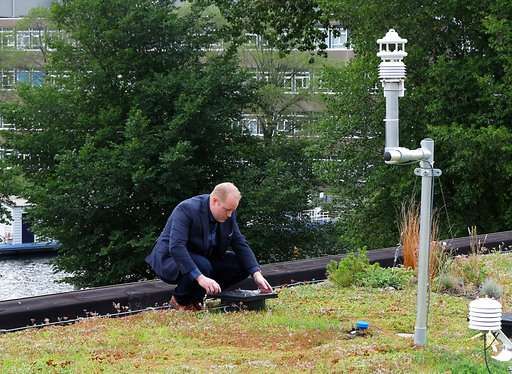Green Roof Design which Stores More Rainwater and Needs Less Energy
Published on by Water Network Research, Official research team of The Water Network in Business
A rooftop garden system on the former hospital roof stores more rainwater than existing green roofs and requires less power by relying on a capillary irrigation system that uses insulation material instead of pumps to water plants.
 Roofs that are adapted so plants can grow on them produce a cooling effect on buildings and the air immediately above them in two ways. The plants reflect heat instead of absorbing it the way traditional roofing sheets do. They also reduce heat by evaporating water.
Roofs that are adapted so plants can grow on them produce a cooling effect on buildings and the air immediately above them in two ways. The plants reflect heat instead of absorbing it the way traditional roofing sheets do. They also reduce heat by evaporating water.
Voeten, of Dutch company Urban Roofscapes, said readings taken on a very hot day showed a temperature difference of up to 40 degrees Celsius (72 degrees Fahrenheit) between his hospital garden above the banks of a busy waterway compared with a roof covered in black bitumen.

In this photo taken on Tuesday, Sept. 5, 2017, Joris Voeten inspects the rooftop garden he helped develop in Amsterdam. Voeten, an urban engineer in Amsterdam has unveiled a new kind of rooftop garden that he says can store more water than existing roofs and feed it to plants growing on shallow beds of soil.
(AP Photo/Michael C Corder)
Robbert Snep, a green roof expert from Wageningen University and Research in the central Netherlands, said the cooling effect is well known, but the new roof in Amsterdam is an improvement on existing designs because of the way it stores water and can feed it back to plants.
Sensors in the shallow layer of soil on top of the water storage elements monitor qualities such as temperature and moisture content. If the soil gets too dry, extra water can be added. If there is too much water, it can be released into the drains.
"The smart roof really ensures that there is evaporation during, for example, heatwaves and thereby they cool the surroundings," Snep, who is not involved in the project, said. "People can sleep well and people can work well in such an environment."
Voeten says his system can be laid on any flat roof with sufficient load-bearing capacity, Voeten said. Costs would likely be around 100-150 euros ($120-180) per square meter (10 square feet), he estimates.
Source: Phys.org
Media
Taxonomy
- Rainwater Harvesting
- Irrigation
- Climate Change
- Green Buildings
- Green Building
- green infrastructure